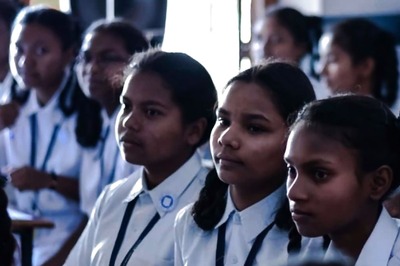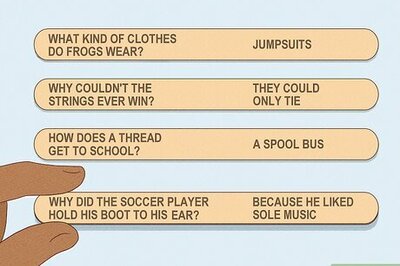
views
This is a classic case of how not to conduct a VVIP security. More so when the said VVIP is a democratically elected Prime Minister of the country.
A Supreme Court committee, appointed to investigate the security breach during Prime Minister Narendra Modi’s visit to Punjab on 5 January 2022, on expected lines, blamed the Ferozepur SSP for his failure in discharging his duty despite sufficient force being at his disposal. The court said that it would send the report of the five-member committee headed by former apex court judge Indu Malhotra to the Centre for appropriate action.
PM Modi’s Punjab visit this January had many dubious distinctions — the first being that an elected Prime Minister couldn’t conduct his rally. He was stalled for more than 15 minutes on a highway. His cavalcade had to take a U-turn as the road was blocked by agitating farmers — all this happened despite the advance intelligence and the repeated instruction provided by the Additional Director General of Punjab Police. To add to this, the then Chief Minister, the Chief Secretary, and the DGP were conspicuous by their absence to receive the Prime Minister, against all established norms and protocols. Apart from being discourteous, this was unprecedented in the history of independent India. The Punjab Chief Minister could at least give the alibi of coming in contact with a Covid-positive person, but the DGP and the Chief Secretary had no such lame excuse either.
Originally, the Prime Minister was supposed to take a helicopter ride to the rally but had to hit the road due to inclement weather. PM Modi’s cavalcade barely covered 30 km towards Hussainiwala when the convoy found itself dangerously trapped on a highway. To the shock and dismay of security officials, the highway was blocked by protesting farmers. As if this were not enough, the agitators could be seen along the flyover and, surprisingly, there was minimal police presence along the routes and the rooftops. In fact, there are video clips showing police personnel on duty enjoying having tea with the agitators. The SPG commandos took up positions immediately and managed the situation with great professionalism, patience, and presence of mind.
After his return to the Bhatinda airport, Prime Minister Modi told the officials present that they should thank the Chief Minister of Punjab as he (the prime minister) could return alive!
Seldom has the nation witnessed such shoddy arrangements for a Prime Minister’s security. The multiple failures would include permitting the agitators to assemble and then travelling by buses on the designated route of the VIP — to top it all, they had the audacity to breach the convoy movement. Obviously, the agitators did not descend from the heavens; it must have taken time to collect, arrange the buses and move to obstruct the VIP. This takes time. In the age of drone technology and real-time intelligence sharing, one really has to try hard to have this kind of security breach and mess up. Also, one wonders how the travel details of the PM could be known to the agitators. These are after all confidential details.
VIP security has never been simple or easy. It is on record that elaborate instructions were issued in the form of printed booklets during the visits and tours of governors, before Independence. Over the years this was fine-tuned and made specific and functional. After the tragic assassination of Indira Gandhi in 1984, it was realised that the security of VVIPs had to be taken to a different level.
After considerable brainstorming study of international best practices, it was in 1988 that the SPG Act was introduced and an amendment was introduced in 2019. This was the beginning and the evolution of the Special Protection Group and the security protocol drills as we find them today.
Over the years, VIP security has become even more complex and challenging.
Under these circumstances, VIP security assumes greater significance and that is why elaborate standard operating procedures have been prescribed so that the security cover is fail-proof and foolproof.
The first step of any VVIP visit is the issue of the VIP programme, which is then fine-tuned to a minute-by-minute detail. Once this has been issued, the SPG team led by a senior officer is sent to the district where the proposed visit is supposed to happen. They conduct advance security liaison meetings (ASL) to discuss all aspects of the visit, like the arrival of the VIP, journey from the place of arrival to the venue of the programme, and if there is a night stay, then identify a suitable, appropriate and secure place for the VIP and provide impregnable security at this location. All medical contingencies are assessed and catered to with super-speciality expertise. A fully equipped ambulance and a team of medical doctors accompany the VIP.
The route of the VIP is surveyed repeatedly and sanitised. Obstructions are cleared, hazards are identified and proper deployment of force is ensured. There are contingency plans to cater to all foreseeable emergencies and alternative routes, places of night halt are identified well in advance, with provision for multiple backups and alternatives. In brief, nothing is left to chance.
Here, we need to know that close-proximity security is the responsibility of the SPG, while the outer security, perimeter security, traffic, fire-fighting arrangements, and armed reserve force are the responsibility of the local police and administration.
This January 5 incident was totally avoidable. Damaging as it is to the prestige of the country, its impact on the credibility and reputation of the Punjab Police was worse still, requiring an immediate course correction.
The Supreme Court committee report vindicates the claims of several security experts, including this writer, who had accused the state administration of putting PM Modi’s life in danger. This was an unacceptable mistake. The SC must be commended for promptly ordering an inquiry and the committee members for doing their job so diligently. Now the onus is on the government to take appropriate action against those who didn’t do their job properly and, in the process, endangered the life of the Prime Minister.
The writer is former Director General of Police, Uttar Pradesh. The views expressed in this article are those of the author and do not represent the stand of this publication.
Read all the Latest Opinion News and Breaking News here




















Comments
0 comment